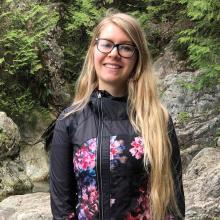Cassandra Miller
Why did you decide to pursue a graduate degree?
After the first semester of the first year of my undergraduate degree, I knew I would end up pursuing graduate studies. There are so many different fields of physics and so much to learn, I couldn’t imagine stopping before even scratching the surface.
Why did you decide to study at UBC?
I have to admit that I was initially attracted to the beautiful campus and the possibility of spending my graduate degree hiking and studying at the beach! UBC is also a world-renowned institution and is performing cutting edge research in my field, so the choice was easy for me. I come from a place where there are occasional -40 degree Celsius winters, so it wasn’t too hard to give those up.
What is it specifically, that your program offers, that attracted you?
UBC has one of the best medical physics programs in Canada, and we have access to leading institutions such as the BC Cancer Centre and the TRIUMF particle accelerator - not every university can say they have their own particle accelerator! Working with the BC Cancer Centre also allows my research to have a clinical component, which not many physicists have the opportunity to do.
What was the best surprise about UBC or life in Vancouver?
For me it was probably the laid back, west coast vibe. Something about being near the ocean is so relaxing. And there are so many great sushi places!
What aspect of your graduate program do you enjoy the most or are looking forward to with the greatest curiosity?
For me it’s the people and the opportunities to get involved. I have made some of the most wonderful friends here and I wouldn’t give them up for the world. I was also very fortunate to spend two years here at Green College (a graduate residence), which allowed me to learn so much about other disciplines and have the most eye-opening conversations.
What do you see as your biggest challenge(s) in your future career?
Figuring out what I want to do! There are a lot of different career opportunities in medical physics, including academia, working clinically, and teaching. There are so many options that I would like to do, I don’t know how to choose.
Fortunately, being at UBC allows me to experience a bit of everything – the physics department has a great TAing program, and I can also gain some clinical experience working at the Cancer Research Centre.
What aspects of your life or career before now have best prepared you for your UBC graduate program?
I did a lot of research projects during my undergraduate degree, which helped prepare me a lot for graduate studies.
What do you like to do for fun or relaxation?
It’s simple, but I really enjoy walking. I take a walk through Pacific Spirit Park at least a few times a week. It’s so close to campus but it’s a great way to leave civilization for a couple hours and just enjoy nature.
What advice do you have for new graduate students?
Trust the process and go easy on yourself! In the first year of my graduate studies, it felt like my field was so extensive and intimidating and everyone knew what was going on except me. But everyone feels that way starting out – one day it just hits you that you have it mostly figured out!!
Learn more about Cassandra's research
Nuclear medicine imaging with PET or SPECT cameras works by detecting photon radiation from inside the body after a patient is injected with a radioisotope that emits these photons as it decays. This radioisotope is attached to a pharmaceutical that binds to specific cells, such as cancer cells – so imaging allows us to determine exactly where these cancer cells are. Radiopharmaceuticals that emit particulate radiation (beta particles, alpha particles, or Auger electrons) as opposed to photons can also be used for cancer therapy – when we inject these radiopharmaceuticals into a patient, the particulate radiation destroys the cancer cells as the isotope decays. Nuclear medicine imaging is used in these therapies to determine the radiation dose to tumours or organs that are at risk. In some therapies, two different radioisotopes are administered at the same time. Each radioisotope emits different decay products, but we usually only image one of them for dosimetry purposes. However, the decay products from the second radioisotope may interfere with our images, causing us to calculate incorrect radiation doses. The focus of my research is on the accuracy of imaging certain radioisotopes in the presence of others, which I’m achieving with the help of Monte Carlo simulations as well as “real-life” radioisotope imaging. Not all radioisotopes used for therapy can be imaged, so I am also investigating how effective is it to use one radiopharmaceutical to predict the dose that a different radiopharmaceutical gives a patient.

